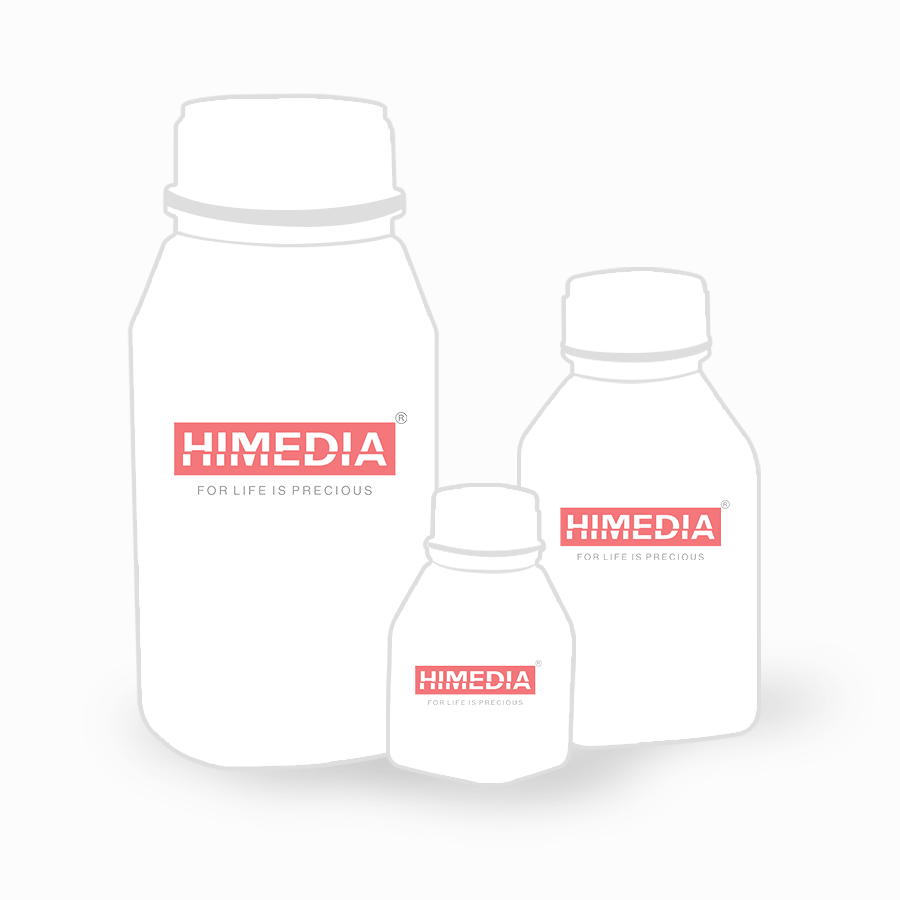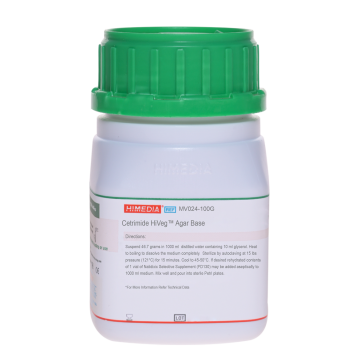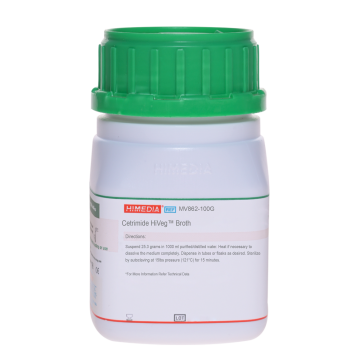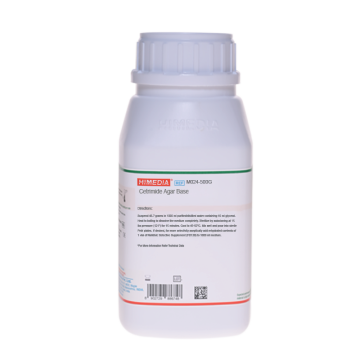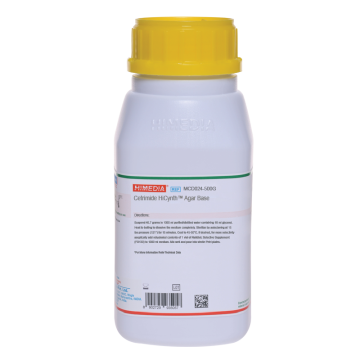 Your enquiry has been submitted
Your enquiry has been submitted
Cetrimide Agar Base (w/ 1.3% Agar)
Intended Use
Recommended for the selective isolation of Pseudomonas aeruginosa from various materials.
Composition**
| Ingredients | g / L |
|---|---|
| Gelatin peptone | 20.000 |
| Magnesium chloride | 1.400 |
| Potassium sulphate | 10.000 |
| Cetrimide | 0.300 |
| Agar | 13.000 |
Final pH (at 25°C): 7.0±0.2
**Formula adjusted, standardized to suit performance parameters
Directions
Suspend 44.7 grams in 1000 ml purified / distilled water containing 10 ml glycerin/glycerol. Heat to boiling to dissolve the medium completely. Sterilize by autoclaving at 15 lbs pressure (121°C) for 15 minutes. Cool to 45-50°C. If desired, rehydrated contents of 1 vial of NA Selective Supplement (FD130) may be added aseptically to 1000 ml medium. Mix well and pour into sterile Petri plates.
Principle And Interpretation
Cetrimide Agar Base w / 1.3% Agar is recommended as a selective medium for isolation of Pseudomonas aeruginosa. It is similar in composition as cited in various pharmacopoeias (1,2,3,4) except that the concentration of agar in this medium is 1.3%. The original formula was described by King et al (5). It can also be used for determining the ability of an organism to produce fluorescein and pyocyanin.
Cetrimide (N-acetyl-N-N,N-trimethylammaonium bromide) in the medium acts as a selective agent inhibiting bacteria other than Pseudomonas aeruginosa. It is a quarternary ammonium salt, which acts as a cationic detergent that reduces surface tension in the point of contact and has precipitant, complexing and denaturing effects on bacterial membrane proteins. It exhibits inhibitory actions on a wide variety of microorganisms including Pseudomonas species other than Pseudomonas aeruginosa. Magnesium chloride and potassium sulphate incorporated in the medium enhances the production of pigment pyocyanin, which is a blue-green pigment, diffusing into the medium. This improves detection of Pseudomonas on this medium. Presence of magnesium ions can also neutralize EDTA, if present in the sample. Gelatin peptone provides the essential nutrients for growth of Pseudomonas, while glycerin/glycerol serves as slow and continuous carbon source for the growing cell.
King et al developed Medium A for the enhancement of pyocyanin production by Pseudomonas (5). Cetrimide agar developed by Lowburry (6) is a modification of Tech Agar (Medium A) with addition of 0.1% cetrimide for selective isolation of P. aeruginosa. Later, due to the availability of the highly purified cetrimide, its concentration in the medium was decreased (7). The incubation was carried out at 37°C for a period of 18-24 hours (8). P. aeruginosa can be identified due to their characteristic production of pyocyanin, a blue, water soluble, nonfluorescent phenazine pigment coupled with their colonial morphology and the characteristic grape like odour of aminocetophenone (9).
For the isolation of P. aeruginosa, plates of cetrimide agar should be inoculated from non-selective medium such as Brain Heart infusion Broth (M210) or Soyabean Casein Digest Medium (M011). If the count is high, the test sample can be directly inoculated onto Cetrimide Agar. P. aeruginosa colonies may appear blue, blue-green or nonpigmented. Colonies exhibiting fluorescence at 250 nm and a blue green pigmentation are considered as presumptive positive. P. aeruginosa may lose its fluorescence under UV if the cultures are left at room temperature for short time. Fluorescence reappears after the plates are re-incubated. Goto and Enomoto recommended that addition of nalidixic acid aids in inhibiting the growth of accompanying flora (10).
Type of specimen
Clinical samples - pus, urine
Specimen Collection and Handling
For clinical samples follow appropriate techniques for handling specimens as per established guidelines (11,12). After use, contaminated materials must be sterilized by autoclaving before discarding.
Warning and Precautions
In Vitro diagnostic Use only. For professional use only. Read the label before opening the container. Wear protective gloves/protective clothing/eye protection/ face protection. Follow good microbiological lab practices while handling specimens and culture. Standard precautions as per established guidelines should be followed while handling clinical specimens. Safety guidelines may be referred in individual safety data sheets.
Limitations
- Some strains of Pseudomonas other than aeruginosa species may show poor growth as cetrimide is highly toxic.
- Further biochemical and serological tests must be carried out for complete identification.
Performance and Evaluation
Performance of the medium is expected when used as per the direction on the label within the expiry period when stored at recommended temperature.
Quality Control
Appearance: Cream to yellow homogeneous free flowing powder
Gelling: Firm, comparable with 1.3% Agar gel
Colour and Clarity of prepared medium: Light amber coloured, opalescent gel with a slight precipitate forms in Petri plates
Reaction: Reaction of 4.47% w/v aqueous solution containing 1.0% glycerol at 25°C . pH : 7.0±0.2
pH: 6.80-7.20
Cultural Response
Cultural characteristics observed with added NA Selective Supplement (FD130) after an incubation at 35-37°C for 24-48 hours.
| Organism | Inoculum (CFU) | Growth | Recovery |
|---|---|---|---|
| Pseudomonas aeruginosa ATCC 9027 (00026*) | 50-100 | Luxuriant (with yellow green pigment) | >=50 % |
| Pseudomonas aeruginosa ATCC 27853 (00025*) | 50-100 | Luxuriant (with yellow green pigment) | >=50 % |
| Pseudomonas aeruginosa ATCC 25668 (00114*) | 50-100 | Luxuriant (with yellow green pigment) | >=50 % |
| Escherichia coli ATCC 25922 (00013*) | >=10⁴ | Inhibited | <=0 % |
| Proteus mirabilis ATCC 29906 (00023*) | >=10⁴ | Inhibited | |
| Stenotrophomonas maltophilia ATCC 13637 | >=10⁴ | Inhibited | |
| Staphylococcus aureus subsp. aureus ATCC 25923 (00034*) | >=10⁴ | Inhibited | |
| Escherichia coli ATCC 8739 (00012*) | >=10⁴ | Inhibited | |
| Salmonella Typhimurium ATCC 14028 (00031*) | >=10⁴ | Inhibited | |
| Escherichia coli NCTC 9002 | >=10⁴ | Inhibited | |
| Staphylococcus aureus NCIMB 9518 | >=10⁴ | Inhibited | |
| Staphylococcus aureus subsp. aureus ATCC 6538 (00032*) | >=10⁴ | Inhibited |
Key : (*) Corresponding WDCM numbers.
Storage and Shelf Life
Store between 10-30°C in a tightly closed container and the prepared medium at 2-8°C. Use before expiry date on the label. On opening, product should be properly stored dry, after tightly capping the bottle in order to prevent lump formation due to the hygroscopic nature of the product. Improper storage of the product may lead to lump formation. Store in dry ventilated area protected from extremes of temperature and sources of ignition. Seal the container tightly after use. Product performance is best if used within stated expiry period.
Disposal
User must ensure safe disposal by autoclaving and/or incineration of used or unusable preparations of this product. Follow established laboratory procedures in disposing of infectious materials and material that comes into contact with clinical sample must be decontaminated and disposed of in accordance with current laboratory techniques (11,12).
Reference
- The British Pharmacopoeia, 2022, Medicines and Healthcare products Regulatory Agency.
- European Pharmacopoeia, 2022, 10 th volume, European Directorate for the quality of medicines & Healthcare.
- The Japanese Pharmacopoeia, 17th edition, 2016, The Ministry of Health, Labour and welfare.
- The United States Pharmacopoeia-National Formulatory (USP-NF), 2022.
- King, Ward and Raney, 1954, J. Lab. Clin. Med., 44:301.
- Lowbury, 1951, J.Clin.Path., 4:66.
- Lowbury and Collins ,1955, J.Clin. Pathol., 8:47.
- Brown and Lowbury ,1965. .J. Clin. Pathol., 18: 752.
- Murray, P.R, Baron.J.H., Pfaller M.A., Jorgensen, J.H and YolkenR.H (Ed.) 2003, Manual of Clinical Microbiology,8th Ed., American Society for Microbiology, Washington, D.C.
- Goto, S. and Enomoto, S.,1970. Japan. J. Microbiol., 14; 65.
- Isenberg, H.D. Clinical Microbiology Procedures Handbook 2nd Edition
- Jorgensen, J.H., Pfaller, M.A., Carroll, K.C., Funke, G., Landry, M.L., Richter, S.S and Warnock., D.W.(2015)Manual of Clinical Microbiology, 11th Edition. Vol. 1.
| Product Name | Cetrimide Agar Base (w/ 1.3% Agar) |
|---|---|
| SKU | M1742 |
| Product Type | Regular |
| Physical Form | Powder |
| Origin | Animal |
| Packaging type | HDPE |
| References | 1.British Pharmacopoeia, 2016, The Stationery office British Pharmacopoeia. |
| Customized Product Available | No |



